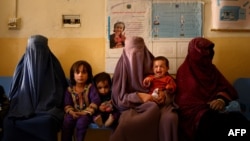Afghanistan has a higher maternal mortality rate than all its six neighbors combined, according to a World Health Organization report released Thursday, and experts say the maternal health crisis is feared to get worse.
The landlocked country’s 620 fatalties per 100,000 live births is the highest in Asia, where most developing countries have made steady progress in improving maternal health care.
Despite the country's improved maternal mortality rates between 2001 and 2021 — prior to international funding that coincided with the U.S.-led invasion, maternal mortality had been reported at 1,346 per 100,000 live births under the first Taliban regime in 2000 — the militant rulers' August 2021 return to power has derailed that hard-won progress.
Now experts say health risks among Afghan women in general are expected to increase. Taliban-enforced bans on women’s education and work "prevent women from accessing healthcare," Brienne Prusak, a spokesperson for Doctors Without Borders (MSF) in Afghanistan, told VOA, adding that the bans have increased medical needs and exacerbated the country's already dire economic crisis.
The bans "have dealt women’s freedoms a grievous blow," the International Crisis Group said in a report on Thursday. "They are also impeding delivery of life-saving assistance, disrupting the world’s largest aid operation even as half the population suffers from acute hunger."
Making matters worse: Foreign donors have stopped development assistance, which accounted for some 70% of public spending under the former Afghan government, crippling the national economy and forcing millions of Afghans into extreme poverty.
"The public health care system in Afghanistan has been underfunded and overburdened for years," said Prusak, adding that health sector funding has dropped significantly since 2021.
Significantly worse
A large majority of Afghans, 88%, either delayed, suspended or decided not to seek medical care in 2022 mostly because of Taliban restrictions and poverty, according to MSF.
"Sometimes, mothers are so malnourished they can’t produce milk," said a medical staff with MSF in Afghanistan. "We see them putting tea in bottles to give to newborn babies — only seven or eight days old — which can be very dangerous."
Meanwhile, human rights groups have warned about a sharp rise in cases of child marriage in Afghanistan, which often result in early pregnancy and serious health risks for young mothers.
While the U.N. and nongovernmental organizations that track maternal mortality have not revised their figures for Afghanistan since 2020, public health experts say the numbers have worsened significantly over the past two years.
"Approximately more than one third (36.6%) of respondents reported that infant/child mortality has 'increased a little' to 'increased a lot,'" reads a report by the John Hopkins Center for Humanitarian Health, citing interviews conducted with dozens of health workers and NGOs in Afghanistan between February and April 2022.
"Approximately one-third (31.4%) of respondents perceive that maternal mortality has increased in their community since August 2021," the report says.
Maternal health indicators have seen alarming setbacks in many parts of the world over the last few years, according to the WHO.
"In total numbers, maternal deaths continue to be largely concentrated in the poorest parts of the world and in countries affected by conflict," the organization said in its latest report.
In terms of global ranking, South Sudan (1,223), Chad (1,063) and Nigeria (1,047) have the highest maternal mortality figures in the world, according to the WHO report, which draws on data from 2020.









